Angkor Wat - the classical image and symbol of Cambodia
Introduction:
Out of the many different countries in the world, Cambodia was never really on the top of my to-go list in terms of birding. It wasn't until my dad said he would be working in Cambodia for a few days at the beginning of May that got me planning for a possible trip. Comparing to other South East Asian countries like Thailand or Malaysia, Cambodia is one of the less travelled by birders, the general infrastructure is not as completed then the other countries, therefore birding on your own here is much more difficult.
However, when birders speak of Cambodia, the first thing that comes to mind is "last chance to see", as this country holds several critically endangered species that is now extremely difficult to find elsewhere, such as the mythical Giant Ibis, the equally mysterious White-shouldered Ibis, the very rare Bengal Floricans and many more...
Aerial view of the Tonle Sap above Chong Kneas
As countries like Laos and Cambodia are now being watched more closely, species new to science had started emerging, such as the Bare-faced Bulbul in Laos, but in Cambodia, the most recent and exciting bird must be the discovery of the Cambodian Tailorbird, a species discovered back in 2008 in the suburb of Phnom Penh, these amazing species make Cambodia an enticing destination for all serious birders.
Other then birds, the rich cultural background of the country also attracts millions of visitors annually to visit the world famous Angkor Wat, ancient monuments from the Khmer empire that once ruled over much of South East Asia from 802AD to 1432AD. These amazing structures are now one of the UNESCO world heritage site, and is considered to be the world's largest religious monument.
Cambodia is also known to many people for it's violent recent history in the reign of the Khmer Rouge under Pol Pot's totalitarian dictatorship, his extremely violent regime killed up to 3 million people between 1975 to 1979, while the later guerrilla war between Vietnam didn't end until 1994. The genocide and other wars throughout the late 20th century took it's toll, but the country is now bouncing back and had been at peace for over a decade.
Traditionally, the best birding time in Cambodia is from December through to April, while May is considered a borderline month and the start of the "low season", it is one of the hottest month in the year, also the beginning of the wet season, so weather becomes less stable. Since my dad already planned his visit in May, we had to suit the birding to his schedule, which was fine by me, as you're bound to see something new when you visit somewhere you never been before!
The plan was for my mum and I to meet dad in Phnom Penh where he will be working for a few days in advance, then we travel together to Siem Reap to join a tour with Sam Veasna Center (SVC), who will operate our birding tour from the 8th to the 13th of May. SVC is one of the top ecotourism tour operator in the region, and regularly run tours for birders from everywhere in the world in search for the many rarities of Cambodia. The NGO is now one of the most trusted birding tour operator in the country and have a good reputation amongst birders, so naturally we decided to give them a try.
We booked everything through the internet, and SVC staff were quick to respond through email, confirming the dates of our tour. There are also plenty of hotels to choose from online, most are not expensive. Direct flights from Hong Kong is available to both Phnom Penh and Siem Reap although being slightly more expensive, my mum and I chose to fly with Air Asia with a connect flight in Bangkok.
We arrived at Phnom Penh safely and my dad picked us up at the airport along with local driver Jackie, whom was most excellent and I highly recommend anyone visiting Phnom Penh to use his service, extremely polite and drove safely, he also spoke quite good English and provided excellent company. That night we visited some missionary friends and had dinner, we planned to start our tour of Phnom Penh together the next day.
Streets of Phnom Penh
Day 1: Phnom Penh - Killing Fields - Security Prison S21
Jackie met us at the hotel front door at 6am sharp, we wanted to bird the area where the Cambodian Tailorbird frequented as early as possible before the mid-morning heat. This legendary bird was discovered on a stretch of river bank bushes and paddies just north of the city, they are now regularly recorded there. The trip took longer then expected due to the morning traffic, Phnom Penh is notorious for the bad traffic and the lack of public transport, so everyone is on scooter or motorbikes, roads were narrow and traffic going both ways didn't help.
Tuktuk - the main form of transportation for tourists in Cambodia
Jackie navigating the confusing streets of Phnom Penh
We arrived just past 7am and went along a few village footpaths to scan along the bushes. There were a lot more birds here compare with the busy city centre. One of the first birds we saw were a male Pied Bushchat, which proofed to be a very common bird in Cambodia. Other common species like Spotted Doves, Zebra Doves, Oriental Magpie Robins and Common Mynas were apparent. Plain Prinias and Yellow-bellied Prinias were common in the bushes as well. We listened out possible Cambodian Tailorbirds along the way.
Habitat where Cambodian Tailorbird was originally found
Pied Bushchat - male
Oriental Magpie Robin - female
Common Myna
Plain Prinia - race herberti looks very different to those in Hong Kong
Yellow-bellied Prinia
Lesser Coucals were easily spotted here, and I managed to get close to one for some good photos. We saw a distant Indian Roller but it flew off before I managed any photos. Plain-backed Sparrows fed by the roadside tree. Green Bee-eaters were spotted. Whiskered Terns drifted past along the river, while a Small Pratincole gave a brief fly-by view, although too quick for me to get any photos.
Lesser Coucal - much easier to see here then in Hong Kong
Plain-backed Sparrow - male
Green Bee-eater
We heard some distant calls that resembled a Cambodian Tailorbird but it was too far to be sure, in the paddies we found a few Zitting Cisticola. Red Turtle Doves were also spotted. Seeing that we didn't have much luck, we decided to head back to the van to escape the heat. Before we returned to the hotel Jackie stopped just outside Wat Phnom to let us see the famous Lyle's Flying Fox colony, where we saw plenty of this now vulnerable species. A cold shower back in the hotel was heavenly and provided a brief escape from the heat.
Zitting Cisticola
Red Turtle Dove
Lyle's Flying Fox
After a brief rest we headed to the Killing Fields. The Choeung Ek Genocide Centre is one of the mass grave uncovered after the Khmer Rouge regime fell, and this particular execution ground is the resting place for over 8,000 victims. The horrifying history of the violent regime was documented in full detail from survivors accounts, and you will be given an audio tour device, of which it will guide you through various checkpoints of the mass graves. You will see pits in the ground that was dug and piled with bodies, many of them were left as they were found, you can still see the occasional pieces of bones or teeth on the ground after heavy rain. One of the most famous landmark is the buddhist stupa at the centre of the site, where 5,000 skulls of unnamed victims have been placed there. The place is now kept in a quiet and peaceful manner, and the gardens are filled with trees and now home to many birds. Indeed this was not an easy place to walk around, with the horrific and tragic stories all going through your head, it's hard to comprehend how this could have happened, and we certainly hope this will never happen again at anytime in the future of humanity.
Mass burial site now protected by rain shelters
Tranquil footpath within the compound
Skulls of victims at Choeung Ek
Eurasian Hoopoe - juvenile
Pied Fantail - juvenile
Green Bee-eater - juvenile
I played a few burst of playback to see if any Cambodian Tailorbirds will respond, and surely enough we heard a few along the footpath by the lake! A few of these small birds came along and sang in the trees above us, at one point one of them gave excellent views and we can fully appreciate all it's diagnostic features! A truly amazing species that still baffles me how they could have been hidden in plain sight. We enjoyed the company of these birds for a few minutes and decided to head back into Phnom Penh.
Cambodian Tailorbird - easily the best bird found in Phnom Penh!
We stopped at the Tuol Sleng Genocide Museum, better known as the Security Prison S21. This former high school was turned into a living hell under the Khmer Rouge regime, where many victims were interrogated and forced to admit to crimes before they were sentenced to death at Choeung Ek or killed on site. The haunting buildings have now been turned into a museum, you can once again join an audio tour similar to that at the Killing Fields. The regime encouraged and manipulated young people to join, torturing the prisoners into giving out names of their associates, whom will in turn be arrested and most of the time executed. In the end, the paranoia of the leadership turned on it's own ranks, arresting and murdering many activists that supported the Khmer Rouge regime, which ultimately led to their downfall.
One of the main buildings at Tuol Sleng Genocide Museum
Haunting photographs of victims on display inside the buildings
Horrifying prison cells in former classrooms
We took a stroll along the riverside before dinner, temperature eases off as soon as the sun goes down. We walked around outside the royal palace for a bit of sight seeing.
Tonle Sap riverside
Royal Palace
Day 2: Phnom Penh - Siem Reap
We overnight at a small lodge dedicated for missionary trips run by owner Mr. Han, the lodge is nice and quiet. We spent the early morning looking out the window of the lodge where we saw some common species, including Yellow-vented Bulbuls, Plaintive Cuckoos and Zebra Doves, nothing overly excited.
Yellow-vented Bulbul
Plaintive Cuckoo
After a church service at the ICA (International Christian Assembly) we said goodbye to Jackie and headed out of Phnom Penh. The domestic flight was quite straight forward with Cambodian Airline, and our friends from Siem Reap picked us up from the airport.
Propeller planes are always fun...
Siem Reap
We had dinner together at Siem Reap and walked around the town centre, less traffic here compare to Phnom Penh was welcoming. The town itself was quite nice and neat, with a lot of restaurants and shops all tourists orientated. When we got back to our hotel, we were greeted by our bird guide from SVC (to my surprise)! Kunthea was friendly and polite, she updated us on the current birding situation around Cambodia, expectation management is always needed for such trips...She told us that Prek Toal will be very dry and it's likely we can't reach the core area, and Giant Ibis may also be difficult to find at this time of the year. Nonetheless I told her that it's our first time visiting Cambodia, so we would see plenty of new birds along the way. She arranged to pick us up at the hotel at 5:30am the next day.
Day 3: Angkor Wat - Angkor Thom - Ta Prohm
We were picked up by Kunthea along with our temple guide Maneer (sorry if I get the spelling wrong!) and our driver. For our first day we planned to visit Angkor Wat for both birds and to see the world famous ancient temples. After stopping at the ticketing building to get our day ticket (which now cost 37USD as of late last year!), we drove to the back entrance of Angkor Wat to start off with some birding in the surrounding forests.
Bird activities were slow, Kunthea spotted a Greater Racket-tailed Drongo nest for us with two newly fledged chicks with the adults close-by. An Asian Barred Owlet perched on an open branch was nice as well, this species proofed to be quite common within the temple complex. Coppersmith Barbets sang from the top of trees and it took us a while before we managed to get a good look.
Greater Racket-tailed Drongo
Greater Racket-tailed Drongo fledglings by their nest
Asian Barred Owlet - the most common owl species at Angkor Wat
Coppersmith Barbet
A perched male Shikra brought a little bit of excitement, it's been a species I've waited for a while to tick off my list, just never connected with them anywhere before, they were in fact the most common species of accipitar in Cambodia. We also connected with two Black Bazas that drifted past, a species I haven't seen for a long time, as they have now became very rare in Hong Kong. We finally managed a glimpse of the Lineated Barbet after some trying, but not what you call a satisfying view.
Shikra - good look at this handsome raptor finally!
Black Baza
Lineated Barbet
Angkor Wat - Ta Kou Entrance
The heat kept us sweating, we sat down in the shade for a few coconuts, Kunthea spotted an Olive-backed Sunbird nest right above our head, the busy female kept coming back to feed her chicks.
Olive-backed Sunbird - feeding young at nest
After lunch, we visited Angkor Thom, where at the centre is the temple of Prasat Bayon, famous for the many faces carved onto the stones, the whole building complex was extremely beautiful and to be able to walk through it felt extremely special. The Bayon was one of only two Buddhist temples built in the Khmer empire. A total of 216 of these giant faces were carved onto the building.
Angkor Thom
The last temple we visited was Ta Prohm, which turned out to be our favourite temple of them all. The temple was made famous by the movie Tomb Raider where they used the temple as part of the film set. The temple is set amongst the jungle, so trees had taken root on the building, somehow creating these beautiful combinations of trees and rocks. The site is also home to a large numbers of Red-breasted Parakeets which we took some time to observe amongst the ruins. A Coppersmith Barbet nest was observed here, we also saw our only Hill Mynas of the trip here.
Ta Prohm
Red-breasted Parakeet
Coppersmith Barbet
Hill Myna
Day 4: Prek Toal Ramsar Site and Floating Village
Walking in the heat all day yesterday was not what you call fun, so we were quite looking forward to the boat trip to Prek Toal. Our first proper birding day saw us waking up at 4:30am, Kunthea picked us up right on time at 5am and we headed towards Chong Khneas ferry port to get on a boat towards Prek Toal. The boat trip across Tonle Sap took an hour, on the way we spotted plenty of Whiskered Terns, but also a large flock of Comb Ducks in the distant. The Tonle Sap is the largest freshwater lake in South East Asia, it is also connected to the Mekong River, where the lake is annually flooded in the wet season, with water level fluctuating up to ten meters within a year! It is a biodiversity hotspot due to this very specific hydrological movements, therefore Prek Toal had been designated as a Ramsar site in 2015. The water level of the lake is highest during November and slowly resides to the lowest in end of April and early May.
Chong Kneas Ferry Port
Whiskered Tern
Comb Duck - our only flock of the day in the distance
Birdwatching at Prek Toal is at best from January through to early April, when water is not the highest nor the lowest and birds are breeding. Although the birds are still breeding during May, the water level was too low for any boats to access the core area. We had to change to an even smaller boat to access the narrow and shallow water channels, the water level was no more then two feet deep, making navigation difficult for our local rangers...the motor getting constantly clogged up by water hyacinth didn't make things easier either, certainly exciting and adventurous though!
Birds were plentiful along the way, with the likes of Little Cormorants, Indian Cormorants, Great Cormorants and Oriental Darters all provided great views. Common birds like Grey Herons and Purple Herons were occasionally seen perched, a few Javan Pond Herons also made an appearance. Yellow Bitterns and Cinnamon Bitterns all gave decent views.
Little Cormorant
Indian Cormorant
Great Cormorant
Oriental Darter
Grey Heron
Purple Heron
Javan Pond Heron
Yellow Bittern
Cinnamon Bittern
Some of the most exciting birds though were a flock of Spot-billed Pelicans at close-range! They provided amazing views and took flight as our boat past by them, providing some great photographic opportunities. Certainly one of the highlight of the boat trip! A few Watercocks also revealed themselves, a female perched just long enough for me to grab a photo.
Spot-billed Pelican
Watercock - female
Another great find was a Grey-headed Fish Eagle also at close-range, this majestic bird of prey is a scarce resident here in Cambodia and indeed much of it's range. I have seen this species in Sabah before but am happy to refresh my memory of this great looking bird! Another bird of prey that we frequently encountered during the boat trip were Brahminy Kites, some of them flew very close to our boat.
Grey-headed Fish Eagle
Brahminy Kite
We eventually came to a point where we could go no further, Kunthea stated that this was merely 20% of the way into the core area, what could be found further inside the narrow waterways we would never know, but we were thankful to the boat drivers and rangers for taking us as far as we got in such dry conditions! The way back was easier as a path had already been cut through the water hyacinth by our motorboat, and we met some more birds such as Darters and Pelicans...
Water Hyacinth blocking our path constantly...Water less then 2ft deep here
Oriental Darters
Spot-billed Pelicans
Kunthea suggested that we head toward Prek Toal village and bird along the way, and it seems like a good call, as we saw hundreds of Asian Openbills feeding along the reed beds, Great and Little Egrets were common here. Flocks of Glossy Ibis flew by. A few Painted Storks flew by but remained quite far.
As we were enjoying views of all the Openbills, Kunthea shouted "Greater Adjutant!", and sure enough we soon locked our bins on a huge bird perched on a tree in the distant, although close enough to pick out all it's diagnostic features. This huge waterbird is one of our main target here at Prek Toal, and due to the low water levels I thought we would never get to see it! So, it was a very nice addition to our trip list and a great lifer for us. This is now one of the most endangered stork species in the world, with an estimated population of just around 1,000 individuals left in the wild. Their decline is linked mainly to habitat lost, climate change, deforestation and pollution. Now, only two breeding populations are left in the world, one in India and the other is here in Cambodia.
As we headed towards Prek Toal village we also added Indian Spot-billed Ducks. Soon our boat was cruising along the floating village, an interesting experience. A lot of these people living in Prek Toal are Vietnamese, whom are not allowed to live on land, their main livelihood being fishing, but during the low season they also keep fishes below their houses. The population in the floating community is around 6,000 and there are basic amenities and services, with schools and a clinic. Rowing a boat or using a motorboat seems like second nature to everyone here, including some very young children.
Our boat stopped at the observatory where we climbed up to one of the very few concrete structures in the village, from there we looked towards the core area, although things were too far away to see properly. Nothing majorly exciting to note were seen, a single Baya Weaver and a heard only Laced Woodpecker were the only highlight. So, we left the observatory for lunch at the floating restaurant. Food were delicious, and being the low season we were the only people there! Perhaps a plus side for coming here in May is that we didn't encounter any other birding tours, which meant the waterways were clear of other boats.
On our return trip we didn't encounter much birds, the cool breeze provided the best setting for an afternoon nap. The only addition before we returned to Chong Khneas ferry port were a few Great Mynas on the shore, a few Large-billed Crows and a fly-by only Racket-tailed Treepie; which was too quick for me to take any photographs but a lifer nonetheless. Above us were over a hundred Painted Storks soaring in the hot air current.
We stopped by a patch of a few paddies and lotus ponds to check on a few birds, there we saw plenty of Oriental Pratincoles, all of which called noisily. Streaked Weavers busy making nests and singing in the tall grass was nice, although they were a bit far for any decent photos. A Shikra drifted past us while I also saw a single Brown-backed Needletail. A Lesser Coucals was around collecting nesting materials. A few Cotton Pygmy Geese in the lotus ponds were excellent addition, but they were again quite far away.
We finally called it a day of what we thought was an overall good day out, it certainly exceeded our expectations for the low season adventure!
To be continued...
Asian Openbill
Little & Great Egret
Glossy Ibis
Painted Stork
As we were enjoying views of all the Openbills, Kunthea shouted "Greater Adjutant!", and sure enough we soon locked our bins on a huge bird perched on a tree in the distant, although close enough to pick out all it's diagnostic features. This huge waterbird is one of our main target here at Prek Toal, and due to the low water levels I thought we would never get to see it! So, it was a very nice addition to our trip list and a great lifer for us. This is now one of the most endangered stork species in the world, with an estimated population of just around 1,000 individuals left in the wild. Their decline is linked mainly to habitat lost, climate change, deforestation and pollution. Now, only two breeding populations are left in the world, one in India and the other is here in Cambodia.
Greater Adjutant
As we headed towards Prek Toal village we also added Indian Spot-billed Ducks. Soon our boat was cruising along the floating village, an interesting experience. A lot of these people living in Prek Toal are Vietnamese, whom are not allowed to live on land, their main livelihood being fishing, but during the low season they also keep fishes below their houses. The population in the floating community is around 6,000 and there are basic amenities and services, with schools and a clinic. Rowing a boat or using a motorboat seems like second nature to everyone here, including some very young children.
Indian Spot-billed Duck
Prek Toal Floating Village
Our boat stopped at the observatory where we climbed up to one of the very few concrete structures in the village, from there we looked towards the core area, although things were too far away to see properly. Nothing majorly exciting to note were seen, a single Baya Weaver and a heard only Laced Woodpecker were the only highlight. So, we left the observatory for lunch at the floating restaurant. Food were delicious, and being the low season we were the only people there! Perhaps a plus side for coming here in May is that we didn't encounter any other birding tours, which meant the waterways were clear of other boats.
Panoramic view of the village
View from the observatory looking towards the core area
Baya Weaver
On our return trip we didn't encounter much birds, the cool breeze provided the best setting for an afternoon nap. The only addition before we returned to Chong Khneas ferry port were a few Great Mynas on the shore, a few Large-billed Crows and a fly-by only Racket-tailed Treepie; which was too quick for me to take any photographs but a lifer nonetheless. Above us were over a hundred Painted Storks soaring in the hot air current.
Great Myna
Large-billed Crow
Painted Stork
We stopped by a patch of a few paddies and lotus ponds to check on a few birds, there we saw plenty of Oriental Pratincoles, all of which called noisily. Streaked Weavers busy making nests and singing in the tall grass was nice, although they were a bit far for any decent photos. A Shikra drifted past us while I also saw a single Brown-backed Needletail. A Lesser Coucals was around collecting nesting materials. A few Cotton Pygmy Geese in the lotus ponds were excellent addition, but they were again quite far away.
Oriental Pratincole
Streaked Weaver - male
Shikra
Lesser Coucal
Cotton Pygmy Goose
We finally called it a day of what we thought was an overall good day out, it certainly exceeded our expectations for the low season adventure!
To be continued...


































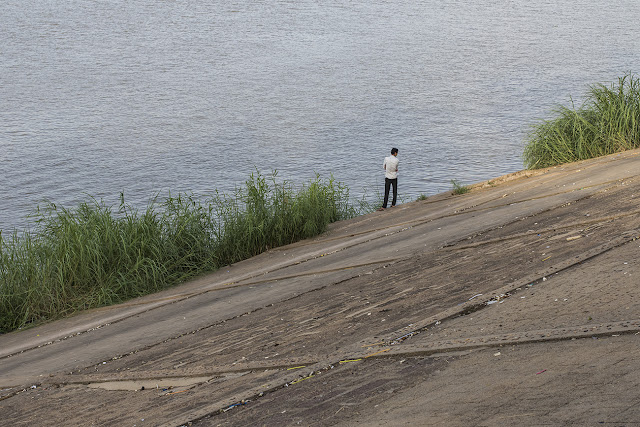




























































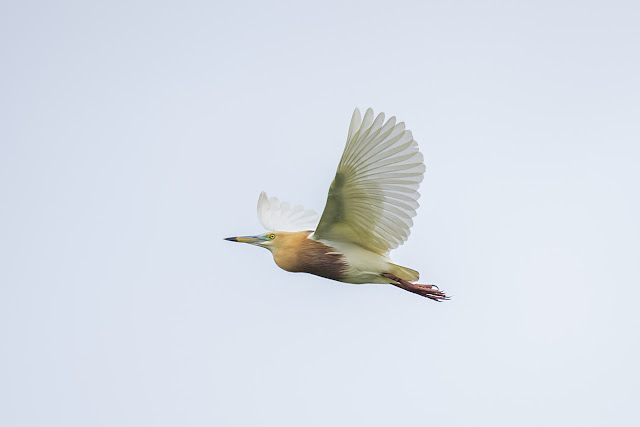






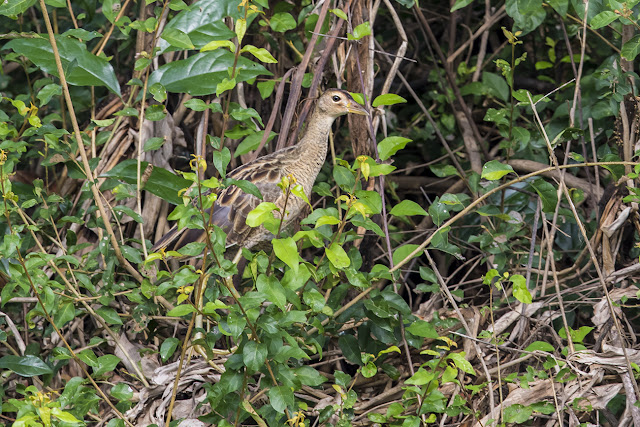
















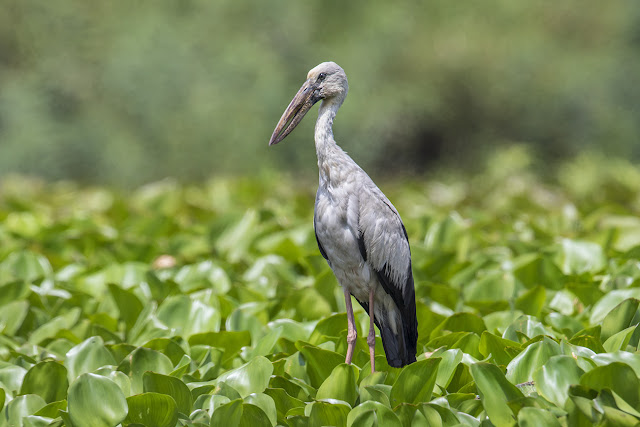














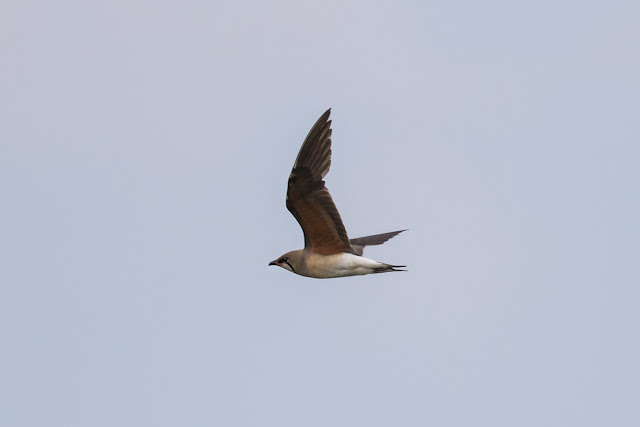




Yes, SVC is one of the greatest birding operators I know so far. And I got around the world many times. Did a 10 day tour with them a couple of years ago. Unbelievably well organized and wonderful sightings of birds and other wildlife. Cambodia is a cool place for travelling. - If you are interested in similar birdlike surpises you might consider a visit to Koshi Tapu Wildlife Reserve in Nepal. A comfortable tent camp is run by Explore Nepal Outfitters based in Kathmandu.
ReplyDeleteLooks like great fun, even in the "Low season" !
ReplyDelete